Public Pier — No Fishing License Required
The Berkeley Pier is closed for renovation and no one seems to know when or if it will be reopened.
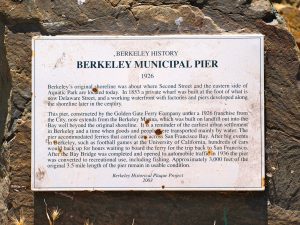
If a survey had been done over the past twenty-five years as to the most visited pier in the Bay Area, the winner undoubtedly would have been either the pier at Pacifica or this pier in Berkeley. This might seem strange since angling at Pacifica had some spectacular “salmon” years and generated a tremendous amount of publicity. But for availability, transportation, ease of fishing, and facilities, Berkeley was hard to beat. Of course it is also located right smack dab in the center of the Rodeo-Oakland-Hayward population corridor. A lot of fishermen live close to the pier and a lot of fishermen use the pier. Of course this is now all in the past tense—the pier is closed (and maybe for good).
This pier should be famous among those interested in piers. It was the first pier to be funded by the Wildlife Conservation Board and showed, after opening in 1959, the cost effectiveness of piers as a recreational resource. For the money spent there are few resources so heavily used — and able to be used by all segments of the population. Since then, more than forty piers have been co-funded by the WCB.
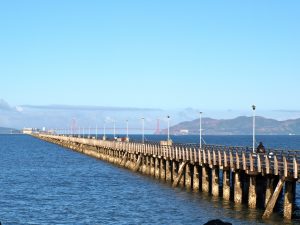
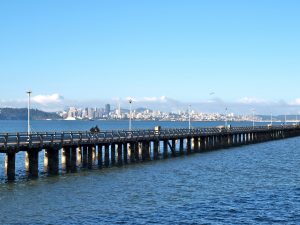
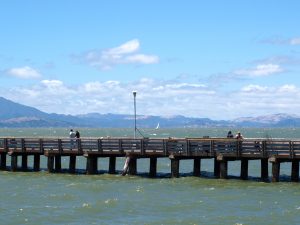
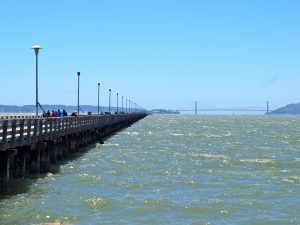
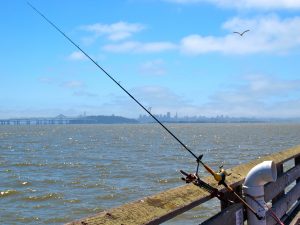
Environment. This pier extends out for more than 3,000 feet; as such, it is one of the longest piers in San Francisco Bay as well as the state. This reflects the shallow water around most of the pier. Bottom is primarily mud and there are few rocks with the exception of the shoreline area. The pier was originally built in 1926 so there are a considerable number of old pilings but mussel growth itself is fairly light. In the summertime there can be considerable growth of kelp along the shoreline
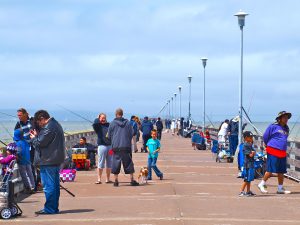
Berkeley Pier Kids Derby — 2013
The Fish. Given the heavy use, it’s not surprising that a lot of fish were caught every year from the pier. However, this is one pier where the regulars really outshined the newcomers in taking fish. The neophyte angler would, much of the year, catch little or no fish, or the catch would be primarily small shiners and bullheads. Regulars on the other hand almost always could find something biting. Use of the right bait, and knowing what time of the year different species are present, will help increase the catch and the regulars had that knowledge.
Numerically, the main species caught here are shinerperch and bullheads (staghorn sculpin) but they made up the so-called incidental catch—and bait for the larger species.
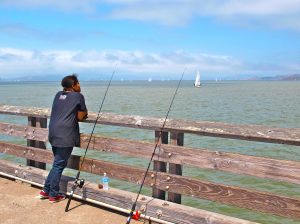
Knowledgeable locals primarily fished in season for halibut (spring through the summer), striped bass (spring into the fall), and sharks and rays (all year). Smaller prey included jacksmelt, pileperch, white seaperch, blackperch, walleye surfperch, kingfish (white croaker), sand sole, and (a few) starry flounder.
Most years would see some large halibut (to 30 pounds), large striped bass (to 45 pounds), and a few sturgeon and salmon. Of interest was a “run” of salmon reported by PFIC regular Robert “Redfish” Gardner that took place at the pier around 1990 with anglers catching fish up and down the pier. Speculation was that it was due to a previous plant of smolts in the area. Keeper-size white seabass have also been recorded from the pier, an uncommon occurrence but still an interesting catch from the pier.
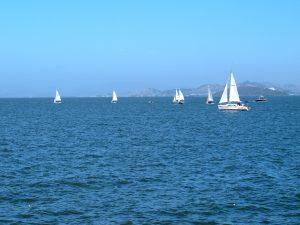
There sometimes seems to be a never ending number of sailing craft and boats on the bay
Among the most reliable of the pier’s fish are the sharks and rays. It is possible to catch brown smoothhounds, leopard sharks and bat rays almost any time of the year, though summer and fall are the peak times.
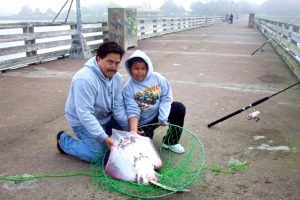
A small “big skate” taken in 2004
One of the most unusual catches at the pier, at least recently, was a close relative of the sharks and rays, a skate. While big skates are fairly common in the bay, this was a sandpaper skate (Raja kincaidii) , a deepwater skate that is rarely caught less than 200 feet deep (and it’s reported down to 4,500 feet). It was caught in May of ’99 by James Pan who reported that it was extremely fun to catch because it actually jumped out of the water once during the fight. However, he also reported that it did not put up as strong a fight as bat rays. What the deepwater skate was doing in this shallow water area is anyone’s guess.
Another interesting report was of a small, 11-inch long barracuda taken from the pier in October 2013. A local bait shop identified the fish but I’ve always wondered if it might have been a lizardfish, a species that had been seen in vast numbers from San Diego to Santa Cruz that year.
Occasionally caught during the late-spring, early-summer months are American shad as they’re traversing the underwater highway that runs from the ocean thru the bay and up into the Sacramento River.
Increasing seen in the past decade are a few sharays that are more commonly seen in southern California. Thornback ray (Platyrhinoidis triseriata), often called pinback sharks or banjo sharks, have become fairly common while an increasing number of shovelnose guitarfish (Rhinobatasproductus), usually called shovelnose sharks, have also shown up. No one is quite sure why the numbers have increased although they are probably left overs from the warm water years that decided to make the bay their home. A few angel sharks have also made an appearance.
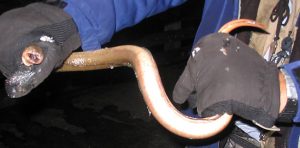
Yellow snake eel caught in 2009 by PFIC regular Mel
An interesting trivia item, at least for those interesting in such things, is that the Berkeley Pier is recorded as the northern limit for the yellow snake eel (Ophichthus zophochir), a reddish-olive to yellow eel that reaches 30 inches in length and whose range to the south is Peru. A catch by an unidentified angler was recorded in scientific journals for April 16, 1964. The fact that the twisty little beasts hang around Berzerkeley was confirmed a second time on June 23, 2006 when a PFIC regular—Mel, captured and filmed a yellow snake eel at the same pier.
Another fish caught about once in a blue moon is white seabass. There have been sporadic reports over the years with the fish generally showing up at the same time they are reported from other East Bay spots. One such occurrence happened in June of 2012 when several fish were reported including one that measured at 46 inches and another at 56 inches.
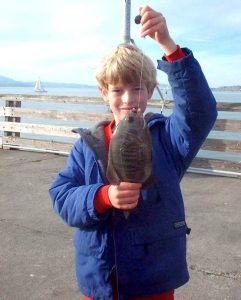
Black perch caught by Minnow Magnet (Justin) in 2004
Upsetting the apple cart as far as conventional wisdom (and scientific records) was a perplexing catch made at the pier in March of 2009 by PFIC regular rockin robin. What he caught was a greenling of some type but no one could positively identify the fish. Soon after a call was made to our esteemed fish consultant—Milton Love at UCSB—who did some checking and then replied: “This is a tough one. It is definitely a greenling. I queried three fish experts from Canada and Alaska, where greenlings are most abundant, and two said it was a whitespotted greenling (Hexagrammos stelleri) and one thought it was a kelp greenling (Hexagrammos decagrammus). Whitespotteds have never been reported as far south as California, so that would be an interesting find if true.”
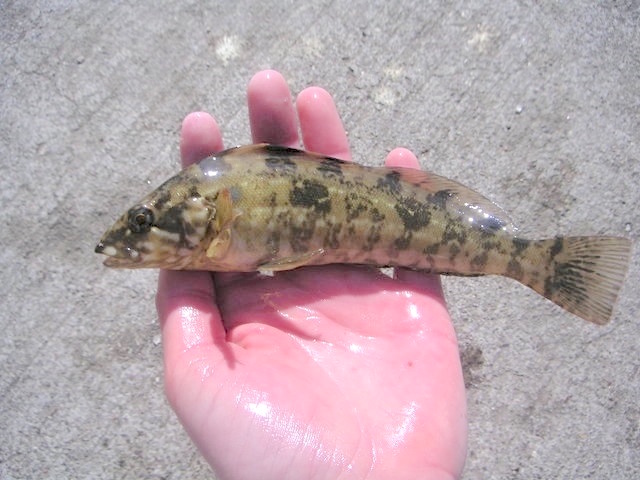
Whitespotted Greenling
Whitespotted greenling are listed and shown in Guide To The Coastal Marine Fishes of California(Lea and Miller, 1972). Their comment: “This species has been erroneously reported from northern California. A description is given to enable proper identification in case it may be present in California.” So could it have been a whitespotted greenling? Since the whitespotted greenling has a listed range from Japan to Puget Sound it would indeed be a considerable extension in range and would call for a change to the record book. I’m not sure what it was but I’ve caught many, many kelp greenlings and never seen one that looked like the fish in question.
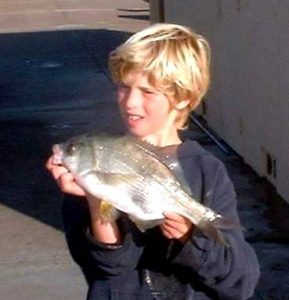
Pileperch caught by Minnow Magnet (Justin)
An interesting little fish that is rarely caught on hook and line due to its small, small mouth is the California tonguefish (Symphurus atricauda). In May of 2015, I received a note from Songslinger, one of the regulars (masters) at the pier, who reported that four to five had been seen by anglers tossing out throw nets for live bait. Initially mistaken for sanddab, Songslinger decided to check the guidebooks and sure enough they were tonguefish. Although their range is listed from Panama to Oregon, they’re considered rare north of Point Conception and certainly a long ways from home at Berkeley Pier.
You just never know what’s going to show up.

Starry flounder caught by Jay
The pier has never been considered a good pier for crustaceans even though a lot of crabs are caught. The vast majority of the crabs attacking bait are illegal Dungeness crabs, illegal because they are too small, illegal because they are caught on a fishing line, and illegal because Dungeness crabs cannot be taken in San Francisco Bay.
A few rock crabs show up occasionally but never enough to actually provide a fishery. Those seeking out rock crabs head over to the other side of the bay and piers closer to the Golden Gate.
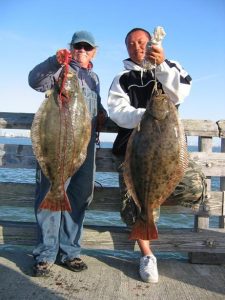
Songslinger (Glen) and a nice halibut — 2007
Fishing Tips. For the larger perch, mainly pileperch, blackperch, white seaperch and rubberlip seaperch, anglers fished as close around the pilings as possible and used pile worms, ghost shrimp, grass shrimp, or fresh mussels as bait. Fishing January through March, using a high/low leader, and using size 4-8 hooks was the method (though small mini-jigs tipped with pile worms also proved effective for the locals). Although the perch might show up at almost any spot on the pier, one of the best areas traditionally was inshore around the fish cleaning station (especially for blackperch). The pier also recorded some redtail surfperch, striped seaperch, and dwarf perch, but their numbers were much lower. Higher in number, although smaller in size, were the walleye and silver surfperch caught at the pier.
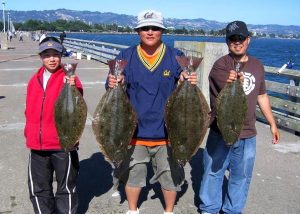
Julie, calrat — 2007
Winter and spring was the best time for starry flounder (although the numbers declined drastically in the past twenty years). Anglers used a sliding sinker leader on the bottom baited with pile worms, grass shrimp, cut anchovy. For the worms, they used a size 4 hook and threaded just enough of the worm on the hook to cover the hook while leaving the point clean. The same rigging, or a high/low rigging, might also yield a few Pacific sanddab during the winter, and possibly a diamond turbot or two during the spring and summer. Best spots to catch the sanddab and turbot seemed to be out toward the end. Summer to fall might also yield some good eating sand soles.
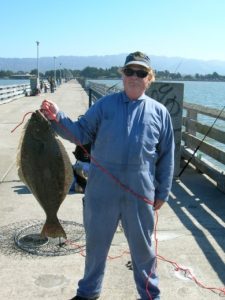
Songslinger (Glen) — 2007
From late spring to fall, but especially late April to early June, the pier could be one of the best in San Francisco Bay, if not the state, for legal-size California halibut. It wasn’t great every year, but it did typically see at least a good short-term run of the fish that congregate in the shallow Berkeley flats around the end of the pier. As mentioned, the regulars were the ones who really caught the big flatties. Live bait, essentially shinerperch, was the bait of choice—if they were around. If snagging and netting didn’t produce the shiners then small smelt become the next best bait. If neither of these was present anglers would settle for frozen anchovies or live grass shrimp but neither is nearly as good bait. At times live anchovies could be purchased at the nearby Berkeley Marina! Since live ‘chovies are the best bait of all for the halibut, it made sense to make a visit to the shop before heading out to the pier (with a bait bucket and aerator).
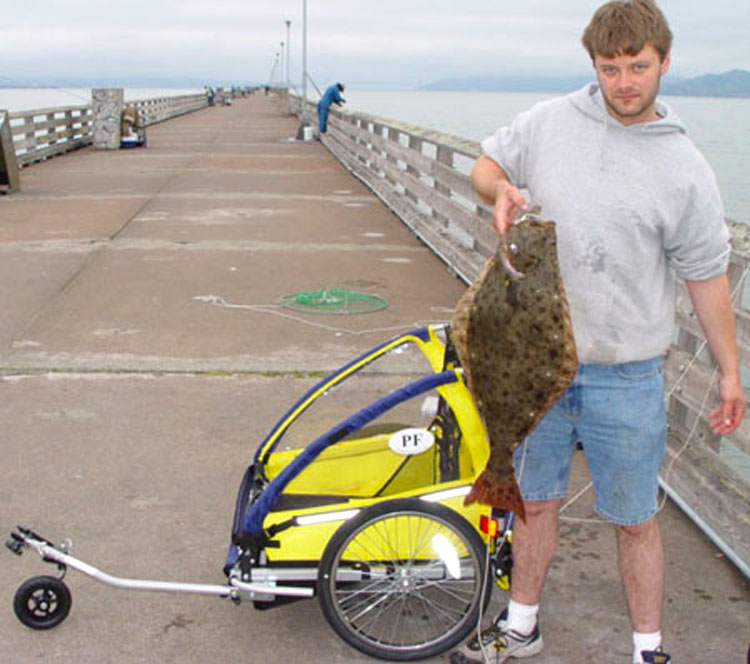
Eelmaster (Monte) with a halibut
The rigging for the live bait was a sliding sinker rigging or the modified sliding sinker with a bobber approach. If unclear on the rigging, people asked the regulars for advice and usually someone would help you out. The funny thing here is that few sub-legal size halibut were caught which is just the opposite of SoCal piers. Most fish would be over 24 inches and many would be over 30 inches; a 46-inch halibut caught in 2015 is the largest that I have seen recorded.
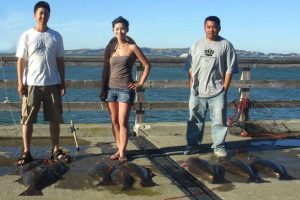
A plethora of halibut — 2008
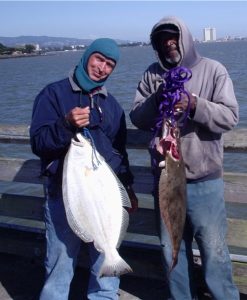
Alabama — 2004
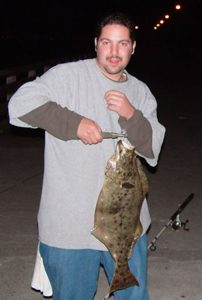
Halibut caught by Rockhopper — 2003
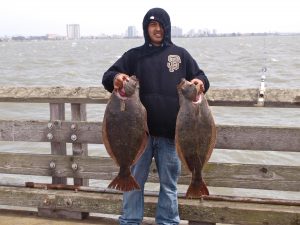
Halibut caught at the Mud Marlin Derby — 2014
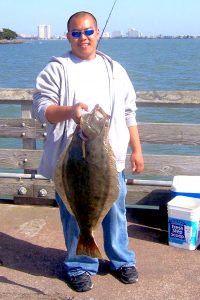
Halibut caught at the Mud Marlin Derby — 2007
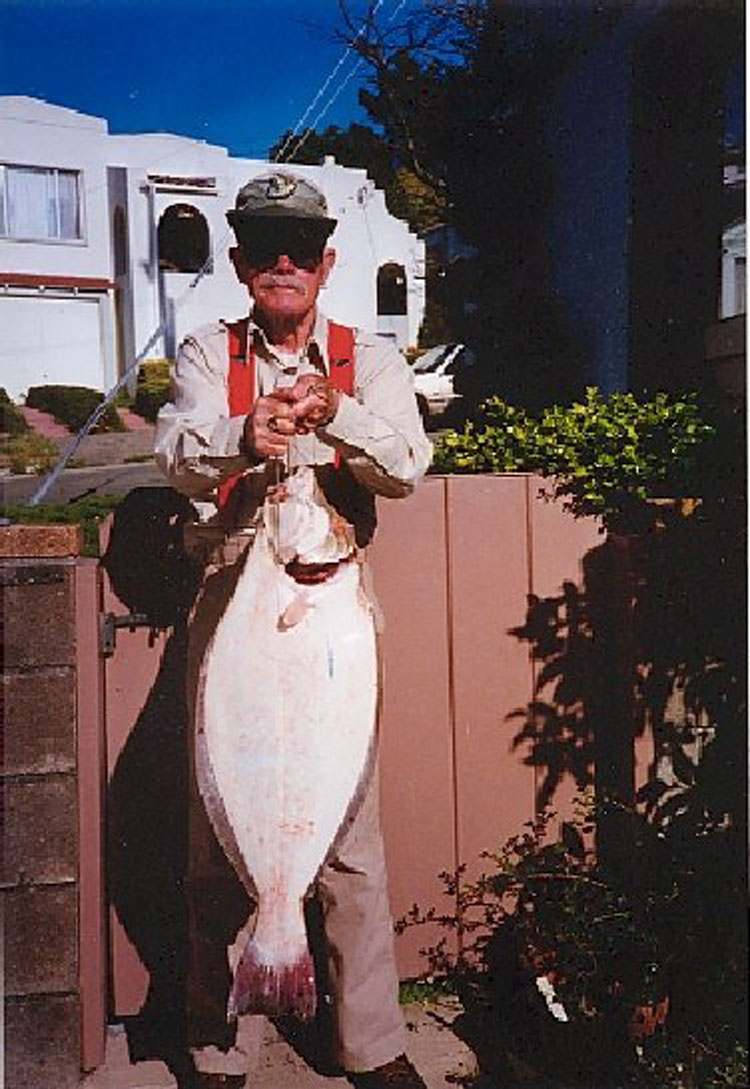
Uncle Ted’s Big One
Striped bass were the second of the big three typically taken from the pier (together with halibut and bat ray). Many stripers were taken every year and most years would see 30+pound fish landed. The stripers could be taken on a variety of baits including live anchovies, shinerperch, and smelt, but also would be taken on bullheads (staghorn sculpin), pile worms, shrimp (grass shrimp and ghost shrimp), as well as frozen anchovies and sardines. Some were taken on the aforementioned sliding sinker method but many were also caught on high/low rigs so it’s a less specialized gambit. The fish were also taken from almost every area of the pier and quite often the primo area was the rocky shoreline area. You could also try artificials for the big bass (spoons like Kastmasters and Krocodiles, top water lures like Pencil Poppers and Rapalas) although the heavy winds that are common at the pier could make casting a little difficult when using a light lure.
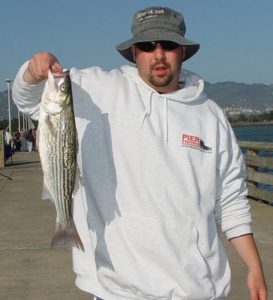
Striped Bass caught by Rockhopper — 2003
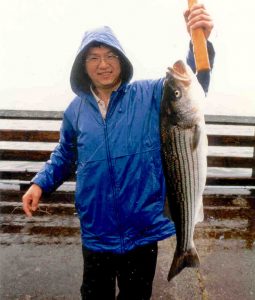
Striped Bass — 2001
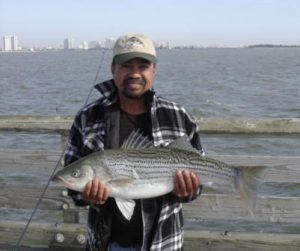
Striped Bass —2007
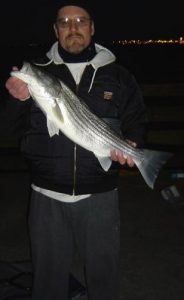
Striped Bass — SideStripeChaser (Bob) — 2006
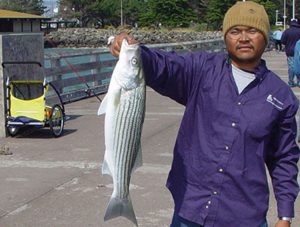
Striped Bass — 2003
Kingfish (white croaker) were one of the more common fish and could be caught much of the year using a high/low leader on the bottom, hooks size 2-4, with small pieces of anchovy or pile worms. Although most any time of the day could produce kingfish, I’ve heard of some very large catches at night, especially during some late January-early February winter months.
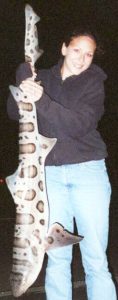
This leopard Shark was caught by Dolphinrider (Lisa), wife of stinkyfingers (Martin) and though I initially thought it was caught on the pier it was actually caught on the nearby shoreline rocks (in 2003). Apparently the same night hubby Stinkyfingers caught a sturgeon. But, it does show how big some of the local leopard sharks can be.
The pier yielded a plethora of sharays—sharks and rays. Small (and large) brown smoothhound sharks, leopard sharks and bat rays led the hit parade. Less common, but occasionally seen, were prickleback sharks (spiny dogfish), 7-gill sharks and (a few) thresher sharks.
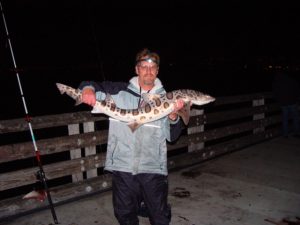
Leopard Shark, SideStripeChaser (Bob) — 2005
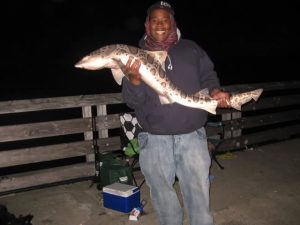
Leopard Shark — 2010
The smaller sharks and rays could be taken on a high/low outfit with size 2-4/0 hooks. Live midshipman tended to be the best bait for the big sharks but anchovies and other frozen fish baits—sardines/mackerel—were the most commonly used bait.
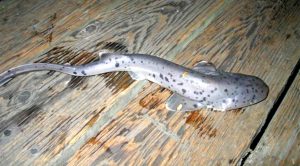
Sevengill shark — 2004
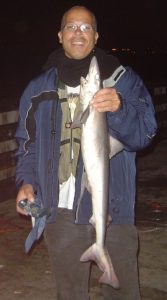
Soupfin Shark taken by Red Fish (Robert Gardner)
The bat rays preferred squid. If seeking the larger beasts, anglers used a sliding sinker leader and appropriately larger hooks (2/0-6/0) and heavier line (40-50 pound test). For almost all of these species, the right side of the pier seemed best even though the wind is usually blowing right into your face. The best results for sharks and rays occurred at night. Many big old mama bat rays approaching, or exceeding, a hundred pounds in weight (the big ones are always females) were hooked each year so it was best to have a net and a friend along to help land the large fish.
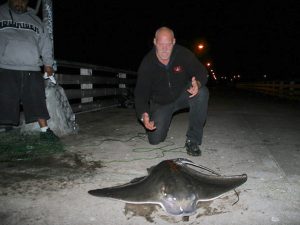
Big Rich (Macintosh) and a bat ray from 2007
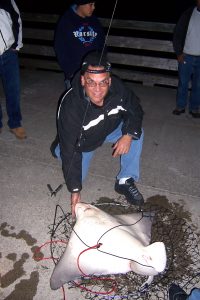
Bat ray caught at the 2007 Mud Marlin Derby
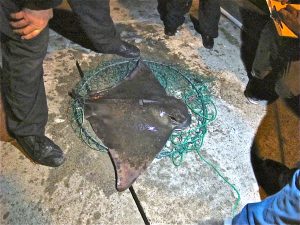
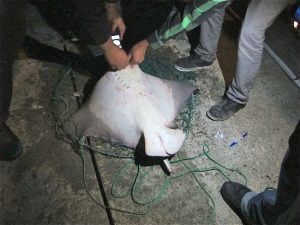
Mud Marlin (Bat Ray) at Mud Marlin Derby in 2014
A few sturgeon generally showed up each year though the numbers were small. Generally ghost shrimp, grass shrimp or cut bait would attract the sturgeon although they would sometimes vacuum up whatever bait happened to be in the water. Given their size, most anglers who hooked a diamondback were unprepared for the fight unless they were using heavy equipment for sharks (or specifically fishing for sturgeon).
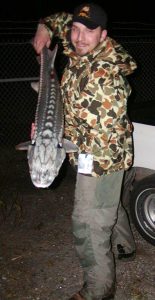
A white sturgeon caught by PFIC member Nufo
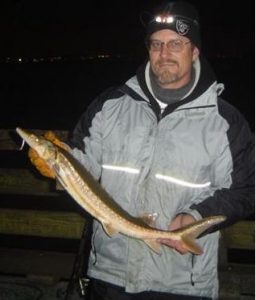
A small green sturgeon caught by PFIC member SideStripeChaser (Bob)
For jacksmelt, anglers used a series of size 8 or 6 hooks attached two to four feet above a light sinker, then placed two to four feet under a float. They used small pieces of pile worm or shrimp for bait, just enough to cover the hook. Schools of jacksmelt typically would stay in one area for a few minutes then leave, only to return a short time later. Therefore many people fished with two outfits, one on the bottom and a second rigged for the jacksmelt—and they would not cast out the “smelt” outfit until they saw a neighbor catch a jacksmelt. Other times the big smelt would “hang” just away from the pier and you would see fish being caught every few minutes throughout the day. Some anglers would also try for the tasty and good fighting smelt by using small artificial lures—primarily small spoons and spinners. Favorites include such spinners as Mepps, in sizes No. O to No. 2, and Roostertails, in sizes No. 1 to No. 3. Best spoons appear to be small (under 1/2 ounce) Daredevils, Little Cleos and Wobbelrites.
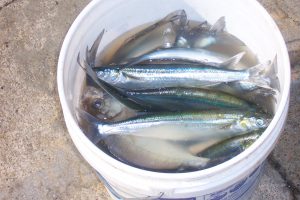
Jacksmelt, catch one and you should catch more
For the youngsters, there were almost always shinerperch and staghorn sculpin present and both were easy to catch. Youngsters could also try the area around the shoreline rocks using a small sinker and one or two small size 8 hooks baited with pile worm. The youngsters might lose a lot of tackle but there were usually a lot of small fish close in, or right under, the rocks. Primary species would be brown rockfish, grass rockfish, kelp rockfish, juvenile black rockfish, and lesser amounts of rock-frequenting species like cabezon, buffalo sculpin, striped kelpfish and kelp greenling.
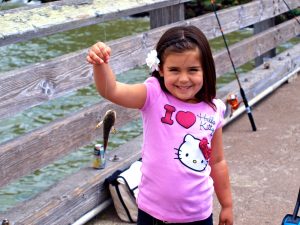
A staghorn sculpin (bullhead)

Even a small crab can warrant a smile
The Pier Rats Speak
Date: March 13, 1999; To: Ken Jones; From: Glen/Songslinger; Subject: Berkeley Pier
This week I checked out the Berkeley Pier. The pier is still low on perch and there are a few kingfish per angler, but not in great numbers. Smelt are still concentrated in the south bay. However, some of the halibut regulars have started to make an appearance. They’re using frozen anchovies because there are no shiners yet, and a few of them have reported catching halibut in the last couple of days. (This has to be related to the recent swarm of anchovies entering the bay system.) Not exactly a run, but encouraging. An associate whose information is impeccable told me that three sturgeon were taken off the pier two days ago. Since the area is still closed for sturgeon fishing and since Berkeley Pier is not known for strict observation of legal sizes, I couldn’t find much else about the diamondbacks. Striped bass are back in San Francisco Bay in a large way (literally) but I’m not hearing too much from pier folks. All the decent catches have taken place along the frontage road adjacent to I-80 in Berkeley.
Date: March 17, 1999; To: Ken Jones; From: Bob Gardner/Redfish; Subject: Berkeley Pier
Can sturgeon be caught at the Berkeley Pier? I’ve never seen one there in 20 years of fishing it. If so, where—beginning, middle or end of pier?
Date: April 15, 1999; To: Ken Jones; From: Jeremy Gale; Subject: Berkeley Pier
Tuesday looked like the day for the first halibut of the year at the Berkeley Pier. Just a bit of a cool breeze from the South at seven o’clock and leaden skies as I stopped half way out to the end to offer my crab net to a couple of young men trying to coax a twenty inch striper into a bucket under the pier. Mission accomplished to profound thanks and so, to the end of the pier to hang anchovies under a couple of bobbers while I dropped a bit of pile worm on a no. 8 hook for shiner perch. High tide in three hours, at which point the water should clear up a bit. There was currently about a foot of visibility. Not too good. The sky brightened and the first shiner perch came aboard to get a nice two-aught bait hook in its nose. Measured the water depth again. Twelve feet deep. So the squirrely little Ms. Halibut Food swam eleven and a half feet under the bobber to mosey about the bottom offering herself to big bad Mr. Butt. Just before the tide changed I caught three more little perch about thirty to fifty feet north of the pier. Funny thing; up until last year most shiner perch would be caught right under the pier or more often than naught, between five to ten feet out from the South side. Last year the little buggers changed their modus.
A nice Korean gentleman who had been fishing cut anchovies began pulling in some really pretty one to two pound kingfish. He was explaining the vagaries of cooking the ubiquitous croaker when I noticed that my little “shiner perch pole” was bent nearly double and in the process of going over the side. A five minute tussle ensued, garnering oohs and ahs from a gaggle of German tourists, before a leopard shark, probably about thirty inches, surfaced to show his handsome face before doing a back flip with a double twist to snap off the four pound leader. Completely unconvinced to cast anchovy chunks and maybe start liking kingfish, I squinted even harder at the two bobbers on an almost flat bay.
It was one o’clock when the breeze began to freshen from the West and I entrusted my rods to the care of my croaker-loving accomplice and strolled down the pier to question the four or five other souls who seemed to be targeting halibut. Not so much as a tale of a nibble from any of them. Everyone concurred that there had been a few butts caught in the last couple of weeks, but that today, glorious sunshine notwithstanding, was not the day. By two the wind was really starting to howl as I broke camp for the mile-long walk off the pier.
No sign of a halibut this day but quite a few shinerperch around. A few folks had caught kingfish, small flounder and a couple of big barred perch. I saw one jacksmelt chasing my worm retrieve but only one person was fishing for them and his face was as forlorn as his bucket was empty. I stopped in at the Berkeley Marina Bait Shop and chatted for a bit with manager Bob Nakaji who said that indeed, a few butts had been bagged on the pier but the real action was just waiting to break. “Any day now.”
Date: April 16, 1999; To: Ken Jones; From: Glen/Songslinger; Subject: Point Pinole Pier
Hey Ken, Yesterday I fished Berkeley Pier. There are many shiner perch now, but still no sign of halibut, though the annual flatfish anglers area already assembled at select locations throughout the pier. Bat ray action is in full swing, with cut anchovies as the top bait. A good number of rays have been caught from mid-pier to the end on the north side. I caught and released a nice-sized 7-gill shark, which gave a good account of itself. Some smelt are there on the incoming tide, and a few kingfish take over on the outgoing, with pile worms for the former and anchovies for the latter. One guy caught caught a striped bass that looked to be in the eight-pound range, but stripers aren’t common right now. The rest of the perch are gone.
Date: April 18, 1999 ; To: Ken Jones; From: Kim Gale; Subject: Berkeley Pier
It was a rosy-fingered dawn and I caught my first shinerperch on the way out to the end of the Berkeley Pier. The party boats putt-putted on toward the Gate as I reeled in the second and last bait fish I would need this day. While feisty little perch with hooks through their noses swam around under bouncing bobbers, efforts to get relief help were hammered by leopard sharks and sting rays who seemed to delight in running off with worm bits and then breaking the hooks or leaders when I had the audacity to put the graphite to ’em.
About seven-thirty I finally had company at the end of the pier when joined by three guys from Richmond toting a jerry-made five gallon bucket filled with a quarter scoop of anchovies “How long do you think those will live?” I almost smirked. “I duuno,” replied Dino Cuccia, “but it sure beats trying to catch those damn shiner perch.” Ten minutes later Dino’s rod tip went straight toward Tibet, and it wasn’t long before a 29-inch, ten-pound striped bass was experiencing labored breathing on the cement.
Turned out most of the anchovies were still living at one o’clock when I left. A bit later at the Berkeley Marina Bait Shop I asked Brian Collier about the amazing endurance of his anchovies. “It’s the potato chips,” said Brian. “What?” “Yeah, old chips, bread crumbs, whatever. We grind it up and feed our ‘chovies every other day. They stay slippery and slimy. You can bounce ’em off the deck and they won’t shed a scale. Most of them can bang their noses bloody against the inside of a bucket and still live for hours.” I digress.
Back to this morning at the pier. The Cuccia party began getting their rods bent one right after the other, but nary a bass or butt. They were in the ‘ray hole’. About every ten minutes someone fishing from the North side of the second half of the pier was running toward Berkeley trying to curb their stingray. Some of these beasties were pretty big, ten to twenty pounds and a lot of folks lost gear under the pier. About noon the shiner perch went blitzoid on the South side toward the top of the tide, but the halibut and bass stayed away. There had been one to four per day butts caught last week. Butt not today. Caio, Kim Gale
Date: May 2, 1999; To: Ken Jones; From: James Pan; Subject: Berkeley Pier
I went fishing at the Berkeley Pier again and results were mixed. I caught one kingfish, 10 bullheads, three bat rays (one weighing over 35 lbs. using my handheld scale) and one sand ray (ID through my Field Guide). The sand ray was a first. It looked much prettier than the picture in the Field Guide. An older Chinese angler next to me caught two walleye (perch), two jacksmelt using night crawlers dug up from his backyard. The Berkeley Pier bait shop owner told me that night crawlers do not work in the Bay, and recommended pile worms, which are more expensive. Now I know what to use next time. One guy caught a halibut using live anchovies just below the pier. No stripers yet. All fish were caught 1-2 hours before the incoming tide and the bite stopped during the slack. Best regards, James
Posted by KJ: James, Thanks for the report. By the way, did you mean sand sole? I’m not familiar with a sand ray. As for the night crawlers, sometimes they will work but pile worms usually work much better. But you are right, there is a big difference in cost, especially if you can dig your won. Sounds like halibut season is just beginning and it should do nothing but get better between now and June. Good luck and catch the big one, Ken
Posted by James Pan: Sorry for the confusion. The “sand” fish I caught was a sandpiper skate. It was extremely fun to catch. This particular skate actually flew out of the water when hooked but didn’t fight as good as a bat ray.
Date: April 17, 2000; To: Ken Jones; From: James Pan; Subject: Berkeley Pier 4/14 and 4/16
Hi Ken, I went fishing at the Berkeley Pier on 4/14 and 4/16. Fished in the morning on both days. Friday I had two solid hook ups on halibut, probably in the 30-35” range. The fish were too big to be brought up with my crab net and I lost both fish. Tried to help another guy with his halibut but lost that one also. Probably in the 35” range.
Sunday I fished from about 7-11AM. There must have been 30-50 people fishing that morning. A lot of the old-timers were there, all hoping to catch a halibut. I had three hook ups this time, lost the first two halibut when trying to bring them in with my crab net, which proved to be too small. Both fish were probably in the 35-40” range. The third one I was not about to give up, and I screamed for help. A neighbor came by to help land this monster halibut. By the time we got it up to the pier everyone was excited and amazed, including myself. The halibut measured 40.5” and weighed 26-lb. This is the biggest halibut I have ever caught on a pier. I took some pictures and will send it to you once it’s developed. I also caught and released a 12” baby halibut.
A neighbor hooked up two big bat rays and lost both. I helped him reset the drag and within 10 min. he hooked up another giant ray. With the proper drag set, he was able to battle the fish for about 15 min. When we eventually brought the fish to under the pier, I was surprised! The monster ray was about 3 to 4 ft in width, and probably weighed 40-50lb. At the end though, the line snapped before we could gaff him.
A few other old timers caught three keeper halibut. I counted ten halibut that were lost yesterday morning! I think most of them do not know much about how to set their drag, and try to save money by using the cheap fishing line, and get overly excited when a big fish is hooked. They just keep on reeling in the fish until the line snaps.
Another gentleman caught a fishing pole and a very nice casting reel. (A Master 7′ rod and Penn casting reel, probably worth more than $100.00).
Overall, this is by far the best fishing day I have had on Berkeley Pier in a long time. Everyone there was nice, willing to help each other out, and shared their expertise. This is what pier fishing is all about!
I will go out again tomorrow during my lunch break with my buddy to try to catch some more halibut. In about a week or so most of the halibut will be away from the pier, and you will need a boat to catch them. The bat rays are biting like crazy if you fish the right tide. Ray fishing should remain good for two more weeks. (Based on the clarity of the water).
A quick survey of the pier resulted in the following count on Sunday morning: four keeper halibut, about five undersized halibut, three smelt, one starry flounder, one keeper bass (~20”), one keeper leopard shark (~40”), and two rays. There were no signs of kingfish and bullheads, or perch. If you like rays, this is the time. Anchovies are the hot bait. Hopefully there will be more people this weekend. The more bait in the water, the better it is for everyone. Regards, James
Date: May 6, 2001; To: Pier Fishing in California Message Board; From: Kim Gale; Subject: Giant Sturgeon at Berkeley Pier
Fished the pier yesterday from 6:15 to 11:15 at the second cleaning station. I had caught a few chunky pregnant shiners at the party boat dock and these, I think, were a little large for the 20- to 24-inch halibut to take an interest in. There were about six halibut caught while I was there…mostly on live anchovies. Shiners were MIA at the pier.
About 9:30 I heard a commotion at the end of the pier and I saw young Jonathan dancing around and shouting. “It’s a sturgeon! It’s a sturgeon.” Sure enough, I next see Jonathan’s father, Thomas huffing and puffing down the pier being towed by a BIG fish. At each light pole he would finagle his rod around it . . . not trusting to hand it to anyone under that much pressure. The fish would come to the surface from time to time displaying its seven-foot self for all to see. Quite a show.
Now, Thomas had been using a live anchovy on a sturdy spinning rig with new twenty-pound test. When the tip went down, he figured a damn ray had mugged him but when the fish exploded out of the water after the first run he knew he had a real problem but a lot of fun ahead. The fish was fought almost down to the second cleaning station and halfway back to the end of the pier before it got smart.
A half hour into the fray, it looked as though maybe Ms. Sturgeon might get netted up onto the pier for a close up, look-see. Not to be. The big fish now decided her best option was to run under the pier instead of along the pier. Smart thinking. She busted loose a few minutes later despite a valiant and skilled effort by Thomas.
There was no way this fish was going to feel the cement of the pier short of being gaffed which would have been just a monstrous crime. So, the saga ended just as it should have. A lot of folks got a good look at a very large fish. Thomas got the sh.. kicked out of him… and was a happy man. And young Jonathan had a whole lot to talk about for the rest of the morning.
Date: May 10, 2001; To: Pier Fishing in California Message Board; From: Dave Mush; Subject: Berkley Pier (A Must Read)
(Edited) Man do I got a story for ya all. First off I would like to state that I have no reason to lie to you folks; with that out the way I can continue with the story. Fished Berkeley Pier last night with five friends, four of which had never fished piers before. Got there about eight and after the first five minutes I hooked into something that I could not get control of. Eventually it ran through the pier and snapped me off. I’m used to loosing big fish on this pier, so I wasn’t tripping. Five minutes later my friend Dave hooked into a sold fish and after a 20-minute fight he had a 57.6 LB ray on the deck. Snapped some pictures and released her to lay her eggs. Not even two minutes later my buddy Brian hooked and landed a 22-pound ray. These two rays were those guy’s first pier fish (not bad). Fishing slowed down for about an hour and then my buddy Brian landed a 5-pound 7-gill. Shortly after, I got a 10-lb 7-gill and while I was fighting mine my fellow pier rat Chris-T-Luv hooked into a monster. After a long, tiresome fight the fished surfaced next the pier. I was the first to see the huge monster and the only thing I can say was “Oh my god” everybody came over to see her, a no BS 7-foot (easy) 7-gill laid before us. With no way to get her up on the pier, Chris had no choice but to cut her loose. Action didn’t stop after that. I hooked into something once again that my 11-ft Ugly Stick, 30-lb test, and Penn 8500 could not handle. But hold, that’s not it. Chris again hooks into something and not even 10 seconds later it lets go. We’re all thinking it’s snapped him off but it turned out that the fish straightened his 4/0 Gamkatsu. Not to keep going but 20 minutes after that Brian hooked something huge that got him under the pier and snapped him off—but only after a 25-minute fight. We also caught about ten sand sharks and one kingfish. All fish came on cut squid. I think Chris and I successfully got four hardcore, and I mean hardcore, bass fisherman into pier fishing. -Dave
—P.s Does anybody now how much a 7 foot Seven-Gill weighs?
—P.s.s As we got there an older cat was walking off the pier with a keeper butt.
Posted by stinkyfinger: Important details
1) “As we got there”—what time was that? And how long did you stay?
2) Where on the pier (1st cleaning station, 2nd cleaning station, further down? by the fence at the end?), and on which side did you cast?
3) How far out did you cast? Or you drop it down?
4) Was it windy?
5) What was your rig (leader size/hook size/where was your sinker)?
As you can tell I am very interested in this. Don’t worry—I’m not gonna swarm the pier with my army and fish it out. I’ve just always had a passion for the seven-gill, and would love to just get one. Please help me out. Thanks. And by the way—congratulations! You are the man.
Posted by Dave Mush: In reply to Important details
1) “As we got there”—what time was that? And how long did you stay? Answer = 8 P.M. till 12:20 A.M.
2) Where on the pier (1st cleaning station, 2nd cleaning station, further down? by the fence at the end?), and on which side did you cast? Answer = Almost at the end on the right side, around 12 lights back from the end of the pier.
3) How far out did you cast? Or did you drop it down? Answer = We got ‘um close, we got ‘um far.
4) Was it windy? Answer = It’s always windy at Berkeley but the wind always dies about 10:30 P.M.
5) What was your rig (leader size/hook size/where was your sinker)? Answer = Not to beat my own chest but it’s my own, it goes like this 150-lb swivel, two feet of 60-lb mono, and 4/0 Gamakatsu (hook), but I think I need to go with a stronger hook. I use steel leader sleeves to attach everything. Rig it with a sliding sinker 4-oz if not windy 6-oz if windy.
Date: June 9, 2003; To: PFIC Message Board; From: jason chin; Subject: Berkeley Pier 6/7-6/8
Fished Berkeley again both days this past weekend. Got there early both days to fish the top of the tide and the tide change. The weather was pretty gloomy both days but the water looked pretty good. On Saturday I managed one striper (23”) released and one halibut (29”). The halibut bit at the top of the outgo and the striper took my last bait of the day at the bottom of the tide. Fished all the way near the end past the 3rd cleaning station on the south side. Got there early again Sunday, set-up in the same spot and on the first two baits put down I got two stripers (23-25”), one on each rod. Both fish were released. My friend I brought yesterday also had a take down and a 30” halibut hit the deck. This action all took place before 8AM and I didn’t have another bite for the rest of the day. Didn’t see too many pierfishing folks this weekend except Ark and my man Slinger. PhishinPat was also on his way in while I was on my way out yesterday. The bite seems to be on first thing in the morning on the tide change and the afternoon incoming. The whole outgo during the day isn’t producing much action. Fish accordingly.
Saturday 6/7/03
1 halibut – slider rig — 1 striper – slider rig — Live Anchovies
Sunday 6/8/03
2 striper – One on the slider, one on the float — 1 halibut – slider rig — Live Anchovies
Jason “bayrunner”
Posted by pescare
Great stuff. Another “Mr Automatic!”
Posted by Red Fish
You outfished the resident ‘butheads. Talked to a couple of them near the end who produced no fish and they said this Filipino guy at the end caught a striper and a halibut (they must of been talking about you). Outstanding achievement. I figured the morning would be good considering that the wind picks up after one traditionally no matter what the tide. Also, the end has been producing the fish now since the last time I talked to you whereas the beginning has not. I’ve all but abandoned that spot save the night because of too much company in that spot. The last cleaning table should produce about as well. There should be another big run around mid-July to early August.
Posted by Songslinger
On Saturday, the day the pictured hallie was caught, the water was remarkably clear for hours down to the bottom of the tide. When Jason got the fish, I had the pleasure of not only watching an expert at work but also seeing the hallie fighting from as far down as three feet below the surface. What a treat! Normally the fish disappear once they are just a foot or so from the surface, but this time it was clear and fantastic, very similar to what you see when fighting a halibut from a rocky shelf on the sea. Those head shakes, too cool! I was so amazed, I nearly messed up the net job when bringing this beauty up to the pier. This was a good battling fish and still flopping like mad even after a half dozen runs. Impressive.
Sunday was less stellar, a little murk in the water and high clouds with steady winds. By the time I rolled up the pier around 9, the action was gone. Dubious highlight during my stay has to be the bat rays, which took the fishermen for a ride, nearly from one end of the pier to the other. To be sure, these were some big fish, yet it also has to be said that the humans on the other end of the line lost control from the start. Any time you cause thirty fishermen to reel in their lines (and relocate live bait offerings to the other side) as you chase a runaway ray down the pier. . . well, let’s be honest, you’ve screwed up. But that is one of the joys of the public pier.
Posted by BigUnInDaBoat
You are the man. I was there Jason, looked for ya but I couldn’t find ya. I fished the first half of the pier… bobber rig, sliders, Hair Raisers, Rattle Traps, live anchovies, shiners, bullheads, and squid. Nothing caught worth mentioning, aka baitfish. Met Slinger, cool guy. Cheers BUIDB
Date: June 20, 2003; To: PFIC Message Board; From: Songslinger; Subject: Berkeley Pier 6/19
Shimano TDR 2703 7′ — Daiwa Regal S 4000a — P Line CXX 15# — Owner SSW Black Chrome Size 4 Hook — Live Shiner Perch On 9″ Leader (Fixed Rig) — H A L I B U T 26″ (Released)
Got on the pier after 3pm and it took about 45 minutes to get 5 shiner perch. Once I did I moved down all the way to the last booth. It was a beautiful day with a reasonable wind, so there were more people than the day before. Lots more jerks, but perhaps I’ll get to that later.
I put one bobber rig out on the south side and the fixed rig on the north. Things were pretty uneventful for the next half hour and more. (Truth is, I saw a couple stripers on a ropes but little else when I was there.) The tide was still coming in and the water was murky—typical coloration following a minus tide. Then I saw the Shimano twitch slightly and knew right away the shiner was disturbed by something. (This is lot easier to detect than on the Tiger, which has a sensitive tip and often looks like it’s getting bumped—I’m constantly told by helpful passersby that I have a bite).
[Two missions going on here: 1) I want to catch the fish, I mean actually set the hook on it rather than grab the pole as the fish is already running. 2) I want to net my own hallie. Insane, but hey, I never get a chance to do this.]
I was on the bite immediately and pointed the rod down. I could feel the fish feeding on the shiner, too cool. A little nibble, munch munch and tug, a pause, and then a return to chomping. I let out a little line, waited a beat, and then set the hook. Fish on! No one was near enough to know I was fighting a fish and I was determined not to put on a show for anybody. This (selfishly) was my fish and my fun. And man, did I have a blast, running and battling a hallie without distraction. Finally it was time to bring it in and I got it to yawn three times. I lowered the crab ring, and this got people’s attention, so by the time I hoisted the fish up, I had witnesses. Good thing I was in control and quiet, because even while I was bringing up the fish I heard morons asking me stuff that they really should have waited with until I was done.
Anyway, fish comes up, fish gets measured, fish gets lowered back into the water and set free. You’d have thought I committed a capital crime! It’s not like I was arrogant and lectured anyone about C&R, but when a guy who should have known better (a veteran I will leave unnamed) goes off on this “what the hell are you doing?” tirade, enough was enough. I spoke in caveman: “My fish, my choice,” and I said no more. So lots of bad vibes for an event that should have brought me joy. Good thing that when Cpansoy showed up a little while later, I was over it and sociable again. Met up with thecrw as well and had a great time fishing with these two gents. (Pierfishing people rock, and if the entire pier was composed of our set, wonders and grooviness would flow.)
Still and all, screw the pier right now. In the last two days I’ve seen tons of garbage and bait strewn all over by imbeciles, fish mistreated, and attitudes that belong in a prison yard. Who needs the aggravation? Not me.
Date: February 5, 2005; To: PFIC Message Board; From: ogreen; Subject: Berzerkeley sighting
Fished from about 1-4pm. Fishing was very slow, jacksmelt being the only action. But, while I was conversing with Fishoff and Finprints about it being low tide I hear “Oh, look at the whale.” Of course my first reaction after looking at the people was ‘tourist,’ yeah right a whale. The water was only about 5’ deep. Low and behold, right in front of me not 8’ from the pier in 8’ of water slowly passes a juvenile grey whale, spouting out it’s blowhole and all! After watching it pass with swirls of mud from around it’s fluke I sat stupefied. Berkeley is just one of those places!
Date: May 1, 2005; To: PFIC Message Board; From: Songslinger; Subject: Re: Berkeley Pier
Thanks for the compliment! It was a slowish day, to be sure, and the minus tide cycle plus the wind ruled the action. I caught and released a 19″ striper shortly after dawn and that was it. I lasted until just before 2. After I left, I heard of a couple hallies lost and maybe two other stripers caught, including one by the legendary Jason Chin. Pretty decent week for me with three stripers (28″+22″+19″) and one halibut (28″) landed. Kept the large striper and the hallie. Mmmm, fish for dinner (and breakfast and lunch).
Some thoughts here: Berkeley Pier, though pretty populated yesterday, was by no means crowded if you compare it with weekends in past years when the halibut are running. Then it is packed like a trout opener on a small lake. It is important to bear in mind such concepts as etiquette and common sense. You may not receive the elbowroom you would prefer–an understatement–yet you do have to cultivate and secure space, while at the same time refrain from being an obstinate jerk about it. And you have to pay attention to conditions. Bobber rigs wander in the wind; for example, so you can’t just lay back and let it tangle someone else’s line. Bells are a nuisance and just a dumb idea when it comes to fishing on that pier during this season.
So too, I have to say, are ray and shark anglers during the daytime, because 99% of them have no idea how to fight the fish without ripping up everyone else’s rigs. With myriad poles in the water, it’s just ridiculous for someone to chuck cut bait out into the channel and then expect people to grab their gear when he chases the fish up the pier. One fool screwing up fishing for many others is not utility but selfishness. Moreover, people who fish for large species and neglect to bring a landing device are royal pains in the buttocks. It is arrogant to assume that someone will dole out his crab ring to help someone else hoist up a huge slimy ray–and often to the point of being left ill equipped himself when a game fish hits his rig. This happens too frequently. Don’t know about others, but I will not trade a striped bass or a halibut for a bat ray. And God help the person who grabs my ring without my permission. He is going swimming in a cold, cold bay.
The guys who catch fish are vigilant and keep an eye on their lines. They check their bait often and ensure its proper presentation. They adapt to the conditions.
Bait is precious. People will often share, but you must not presume, especially when it comes down to the fact that they’ve paid $10 for a scoop of anchovies and they want it to last the whole day. If you are catching your own bait, hey, cool, it’s great to be self sufficient. But if you are throwing your cast net close to anglers’ lines, not cool. Even if it’s on the opposite side, some guys get irritated. So ask, or at least say hello and be courteous. Works wonders.
Date May 5, 2005; To: PFIC Message Board; From: Songslinger; Subject: Berkeley Pier 5-04-05
…Berkeley pier in rain
storm washed tabula rasa
all is possible…
The threat of rain kept most people off the pier yesterday. But true aficionados (a-fish-a-nod, oh) are never intimidated. Especially when the signs are excellent. The approach of a storm usually means less wind or even a calm period, an increase in temperature, and fish reacting to the drop in pressure. They do this by moving towards open water and feeding actively before conditions roil up the habitat. And when you get a slow incoming tide in the morning… Ideal for halibut angling in the Bay. Change is good. Jason Chin and I planned this the day before and were out near the end of Berkeley Pier around 7:30. He had a bucket full of nice medium sized live anchovies. (I probably owe him $200 for all the live bait over time, but hey, it’s in my other pants pocket.) Four rods out on the south side, one each on the float rig and one each on the basic egg sinker.
We had about an hour on the pier to ourselves. The water was like a mirror bordered by low white clouds that concealed San Francisco and Marin. Loons called from the mist. Cormorants yawped and mush ducks mushed. A sturgeon jumped and splashed behind us. Kurt and Mike rolled up and bivouacked a few shelters away. Occasional drops of rain were grudged out of the sky; thunder rolled over El Sobrante; but the storm was still hours away.
High tide was predicted between 9:45 and 10. By 9 Jason had the first one in, a sweet lady fresh from the sea, 34” of fat halibut. How fresh? Sea lice were still on her. She can’t have been in the Bay long and more than likely ventured in during this tide. Jason’s hook set was perfect, timed exquisitely and stuck right in the corner of the mouth, and he played the fish masterfully. Mike hoisted the fish well considering he hates crab rings and complained about it the whole time. About 15 minutes later it was my turn. I saw the float descend slowly and had the rod in my hand, feeding a little line and trying to sense the beast on the other end. A little tug and I tugged back harder, another perfect hook set. Mine was centered in the upper palate of the fish. This time Jason was on the crab ring. Decent fish slapping on the cement. She was 29” and no sea lice were present. Always cool to actually catch these fish rather than run to your pole when it is hit. Both butts hit bobber rigs.
The tide changed, a breeze came up, more intermittent raindrops, and not a single bite. By 1:30 it was raining in earnest. This one guy setup down from us and put out a whole frozen anchovy on a large freshwater bobber. Within a half hour he had a fish on, a nice 25” halibut. I netted this one, completing some kind of cycle. Jason left to beat the traffic and I headed back down towards the entrance where I put out two striper rigs and got lost in the timelessness of the steady rain. No more fish for me. Kurt and Mike gave up around 4:30 and said that only one really small hallie was caught, again by the man who had the other butt. He was jigging when he got the short fish, which he promptly returned.
So only four fish on the pier for the day. But you couldn’t catch them if you stayed home.
BWS1100 7′ Ugly Stik — Shimano Sahara 2500 — P-line CXX 10# — Gamakatsu black octopus #1 — Small float rig and 1/4oz sinker
Sorry for the long report. But it’s my only one for BP for the season. I have not changed the way I fish there enough to make other reports. But oh yeah, Jason and I did the same thing last week, with one halibut each. Even so, he’s way ahead, with 5 on that pier this season. Phong, look out, young dude: who is the padawan now?
Date: May 26, 2006; To: PFIC Message Board; From: Songslinger; Subject: Using lures for stripers off Berkeley Pier
Keep in mind that you are fishing from an elevated platform, so you need to adjust your retrieve accordingly, even in an exaggerated manner at times. Jigs like hair raisers (w/wormtails) in white and chartreuse are effective; so are swimbaits that resemble the local little baitfish. Big Hammers in colors like anchovy and smelt have worked for me. Rat-L-Traps are hard but not a bad choice on the severe low tides; stick with dark backs and chrome. Spoons like Krocodile can do the trick but are hard to keep consistent on the retrieve. Kastmasters, same deal.
Go as light and as small as possible. Color is dictated by water clarity as much as ceiling conditions. Target species with dedication: hit or miss throwing will…miss. In my view, you will see better results the closer you are to shore, and it’s a good strategy to throw just in front of the rocks and pull away slowly. Good luck!
Date: June 20, 2006; To: PFIC Message Board; From: Songslinger; Subject: Pretty Good Day On Berkeley Pier 6/19/06
A particularly irritating onset of neuropathy forced me to get out of the house and go fishing. Yeah, lame excuse, but really, one of the best remedies for numb and tingling fingers is throwing the cast net hard. I got to the pier parking lot between 1:15 and 1:30. Calrat and Julie were unpacking their car and just setting out, always a good sign: lately I’ve tried to set up in their group so they can teach me how to fish.
The tide had already bottomed out at about a foot and a half and was just turning over to begin the march up to six feet around sunset. Winds were out of the West and blowing steady from five to ten knots. The water was translucent and choppy. For a Monday afternoon the pier was fairly populated, several groups spread out with their bubbling aerators and bait shop anchovies ready to go. I joined Calrat and Julie where they established a niche by the last cleaning station. SkunkenQ was there along with Oscar. Nearby was the enigmatic Morone. Nieto was there, too.
Q had some shiners, so I put one out on each rod. I decided, once again, not to use the float rig due to the wind and water movement. Time passed. Though conditions seemed ideal, nothing much happened along the pier. Those with fish had caught them hours earlier. The baitfish were everywhere and came in large numbers with the tide. Q threw and got some jacksmelt, so I followed suit. A few throws yielded some anchovies and jacksmelt, which I stowed in the troll bucket. One rod got a tail-hooked big boy and the other retained the shiner. I’ve been cautious about live anchovies because lately they have attracted shaker halibut and even some bat rays. Oscar got a medium sized ray on a live anchovy.
But desperation overcame caution, and I added a trolley leader to the shiner pole. Down went a large wriggling anchovy. Soon after, maybe less than ten minutes, that pole bent over and the little 2500 reel rang out like a watch alarm. No question: bat ray on. Well, hell. Apparently a big one, because it took line out rapidly and relentlessly. I had two different 10# mono lines on the spool, the unknown clear stuff Shimano put on and the P-line I added. In short time the P-line was out and the clear stuff peeling madly off the spool. A blood knot joining the two lines was my weakest link. Yet I got the fish to turn and come back, perhaps with 20 yards of line left on the reel. Lots of drag and several runs ensued before I could get it to the pier. Once I screwed up and let it go under the pier, but I refused to yield and won the day. Calrat got the crab ring down and it took two of us (well, mostly him) to bring the beast up. Nice ray, 40” across the wings, easily 50#, but everyone there said it looked even heavier. The body was FAT. Back into the water went the ring and ray, which swam off beautifully. I fought the fish for 20-30 minutes. My arms were sore.
So of course the other pole went off moments later. The halibut was a nice 28” female and the fight, accentuated by my tired state, was worthy. On a rope she went and when I checked my clock it was just after six. Time to bleed the fish, pack up and go home.
For the bat ray — Ugly Stik BWS 1100 7’ — P-line CXX 10# — Unknown Shimano line, maybe 10#, probably less (Shimano does not like heavier line on the smaller spinners) — Shimano Sahara 2500 — Owner SSW #4 hook(s) — Standard drift rig with 2oz ball, plus trolley leader
Shiner perch and anchovy (I think the ray hit the ‘chovy, but everything was hopelessly tangled at the end of the fight)
For the halibut — Shimano TDR 2703 7’ — P-line CXX 15# — Daiwa Regal S 4500 — Owner SSW #4 hook — Carolina rig with 1/2oz egg sinker — Jacksmelt hooked in the tail
Date: June 26, 2006; To: PFIC Message Board; From: Songslinger; Subject: Pier Security
Just a thought or two on the good old summertime and thieves. Lately on Berkeley Pier we’re noticing a number of solitary faux fishermen. These guys carry one rod with an unbaited hi/lo. They work their way up the pier and almost blend in. Their strategy: wait for someone to hook up a good fish, and when curious or enthusiastic anglers vacate their fishing stations, the thieves move in and help themselves. No one pays much attention to a guy leaving the pier with gear and tackle, right?
This can be avoided. Secure your equipment. Don’t leave your gear unattended. Keep on an eye on your stuff and also on the passersby. Opportunity and expedience–these are two key words for the rip-off bastards. Most of the time, all you need do is make it harder for them, too much work to steal your stuff. Observe people and let them see you seeing them. You don’t have to be overt or rude. If they sense you are on top of things, they will probably seek another easier target. Above all, don’t get caught up in the joy of someone else’s catch if it means taking your mind off your own situation.
For those here who want to chime in with the old “I carry weapons” cliche, I say, “Yeah, fine, but wouldn’t you rather not have to use them at all?” If your answer is in the negative, you need to stay far, far away from me. I’m over that mindless juvenile violence crap. Protect yourself, absolutely—that is common sense. But an ounce of prevention, ya know? (This is a cliche that works.) Let’s all practice Safe Catch in every sense. Peace, slinger
Date: Feb 20, 2015; To: PFIC Message Board; From: Songslinger; Subject: 46” Halibut at Berkeley
Not a misprint. Really. 46 Inches, taped. And not mine. But I was there and saw the fight, the netting, and witnessed the measurement. The angler is not a Net sort of fellow, so I will respect his privacy. I’ll only say that he is a man of advancing years that many regulars would recognize on sight. Always uses live shiners imported from south bay. Always hangs them under a bobber. The fish was caught during the second hour of the outgoing tide today, near the last sink. Biggest one I’ve seen on this pier. I’ve been present for two, maybe three, fish above 40” at Berkeley, but that was over a decade ago. An early score. And an impossible benchmark.
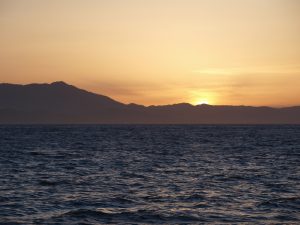
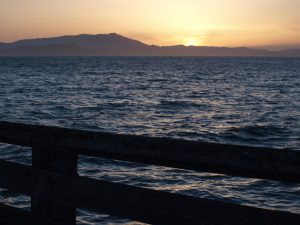
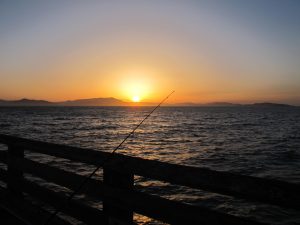
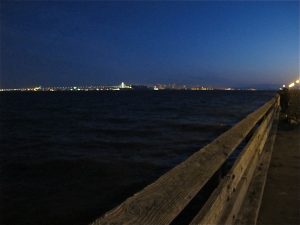
Mud Marlin Derby — 2014
Potpourri
<*}}}}}}}}}>< — One day there was a post on the PFIC message board about an East Coast pier that received complaints because of its disgusting smell. A Brooklyn newspaper article was quoted with the interesting title “Hook, line and stinker!” In response DSRTEGL, one of the log-time board members replied, “They should visit Berkeley Pier during a hot day in July or August… The stench in some areas could knock a buzzard off a gut wagon.” Be forewarned that cleanliness was not a strong suit of the pier.
<*}}}}}}}}}>< — In April of 2015 I received a picture of a large spiny lobster that had been taken from the pier, the catch supposedly made in 2013. The catch is interesting since this area is far north of the “bugs” usual haunt (SoCal south) and none of the regulars had ever seen such a catch from the pier. Speculation centered on the idea that the lobster had been released by a group of orange-robed Buddhists who every year release critters (fish, clams, mussels, and possibly lobsters), back into the Bay as part of their annul “Celebration of Life.” At one time they released a variety of creatures into the bay from a variety of stores but when it was pointed out by pier rats that they might be releasing illegal, invasive species, they began to make sure only local species were released. Some wondered if the lobster was released before the change in tactics. We will probably never know.
We have also seen reports of “Maine/Atlantic Lobsters” taken from the Fort Baker Pier and once again theorized that they were released by someone, either from a religious or environmental group. (Picture courtesy of sofaking).
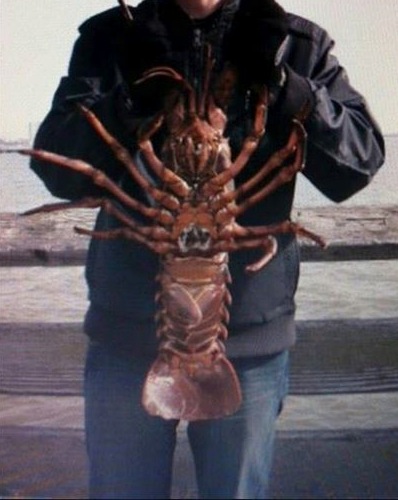 This spiny lobster taken in 2015 was a long ways away from its SoCal home
This spiny lobster taken in 2015 was a long ways away from its SoCal home
<*}}}}}}}}}>< — Special Bay Area Regulations:
- A perch closure exits in San Francisco and San Pablo Bay from April 1 to July 31. No perch may be kept other than shinerperch (20).
- In San Francisco and San Pablo Bay a fishing line may not contain more than three hooks.
Sturgeon Regulations:
- A sturgeon report card and tags are required for anyone fishing for or taking sturgeon. (a) The card must be in the angler’s possession; (b) a tag must be used for any sturgeon retained by the angler; (c) the angler must record information on the Sturgeon Report Card immediately after catching and keeping or releasing the sturgeon.
- White sturgeon can only be kept from 40-60 inches; larger and smaller sturgeon must be released.
- Green sturgeon may not be taken or possessed.
History Note. The history of this site goes back to 1854 when James Jacob built a small wharf just a few hundred feet north of today’s University Avenue. His wharf was the first for Ocean View, the village that eventually would become West Berkeley (and then be absorbed into Berkeley proper). He dubbed his wharf Jacob’s Landing and used his sloop to haul both freight and passengers; it became the first ferry in the area. Two years later a lumberman named Zimri Brewer Heywood arrived. With Jacob, he helped develop a lumber yard and a new, more substantial wharf which could be used to haul lumber throughout the area.
In 1874, a pier was built for a new Berkeley-San Francisco Ferry. Its history, as well as that of its successor, was one of conflict, bad timing and financial problems. The first conflict was with Jacobs and Heywood who felt that the ferry should land at the foot of Delaware Street, the site of their existing wharf. They lost out to the other members of the Berkeley Land and Town Improvement Association (who founded the ferry service). $82,000 was raised by subscription to start the Berkeley Ferry and Railroad Company, to buy a ferry boat, and to build the pier. However, after legal and financial problems arose, the Standard Soap Company (as the underwriter of the project) had to step in and the pier was built.
The ferry opened in October of 1874 on a site much different from today’s. The shoreline was beachfront property, primarily sand and mud. It was however, like today, shallow water and the pier had to extend out 1,300 feet into the bay. At the end of the pier a dock was built where the ferry landed.
But events did not work out as planned. Rival railroads competed in taking passengers from Berkeley down to the Oakland Mole and its Central Pacific (later Southern Pacific) ferryslip. Since that ferry provided a faster and more comfortable ferry ride, it spelled doom for the Berkeley Ferry. By 1876, the original Berkeley-San Francisco Ferry service was over, although the pier continued to be used for general commerce into the new century, and was bought by the city of Berkeley in 1907.
In 1923, a new plan was proposed. The Golden Gate Ferry Company would re-establish direct transportation between Berkeley and San Francisco. The site was at University Avenue, the same site as the original ferry pier. A change was that the new ferry would be built for people in cars (and later those on buses). The original pier was torn down, a new three-mile-long wharf was built, and service opened in 1929 with the inaugural voyage of the ferryboat Golden Bear.
Once again, the timing was bad. On November 12, 1936 the San Francisco-Oakland Bay Bridge opened as the world’s longest steel bridge (8 1/4 miles, 43,500 feet — including four miles over water), an event which doomed the ferries. Soon, the ferry company (which was now jointly owned with Southern Pacific) offered to give Berkeley the pier, and their fifty-year ferry franchise — for free. Berkeley accepted the offer and now had a municipal fishing pier. Although the city received the pier as a free gift, fishing wasn’t free for the anglers, a tourist guide published in 1940 listed the pier and its fee of 5 cents.
Just as quickly, the pier became a Mecca for local anglers (although during the early and mid-’40s, the World War II years, part of the pier was declared off limits). In 1955, Berkeley considered closing down the now somewhat decrepit pier. Protest was loud and clear; a regular occurrence in Bezerkeley. In stepped the California Wildlife Conservation Board which offered to fund half of the money needed to renovate the pier. 1959 saw 2,000 feet of the pier refurbished; an additional 1,000 feet were finished in 1962. The resulting pier was the first in what is now a long list of recreational fishing piers built or renovated in partnership with local cities and counties and the Wildlife Conservation Board.
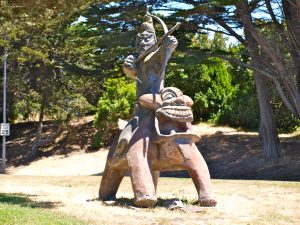
Berkeley Pier — CURRENTLY CLOSED
Hours: Open 24 hours a day.
Facilities: There is free parking near the entrance to the pier. Restrooms, fish cleaning stations, benches, wind breaks, and lights are all located on the pier. Bait and tackle is available nearby in the marina at the Berkeley Marina Sportfishing Center. There are several restaurants within walking distance of the pier and usually there are food vendors near the entrance to the pier itself.
Handicapped Facilities: There are some handicapped parking spaces and the restrooms are marked for the handicapped. The surface of the pier is concrete and the railing is approximately 40 inches high.
How To Get There: Take I80 to University Avenue in Berkeley, turn west and follow the road to the pier.
Management: City of Berkeley Marina Sports Center.
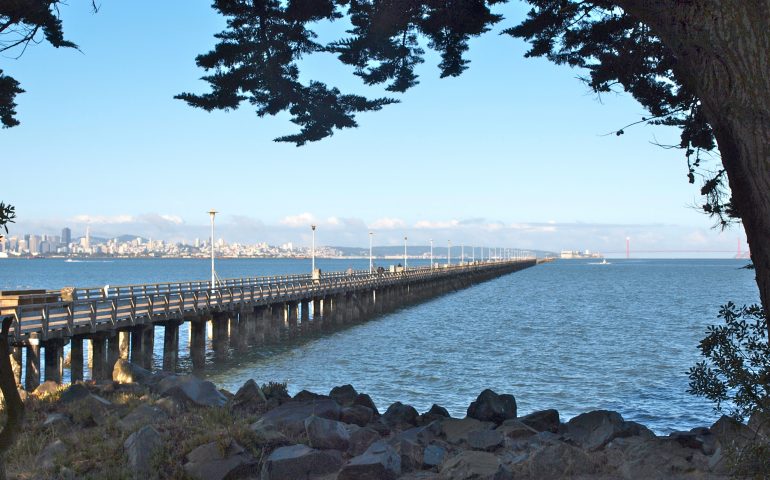
My husband Ernie used to use the Berkley Pier all the time until it was closed down he would LOVE to still use it when ever it is open again. We come from Fairfield CA. but the drive is worth it to make him happy, he just turned 73 on Christmas Eve, his dad fished there in a wheel chair with 1 leg missing until he died, PLEASE let us know when it is opened, phone # 707-428-5569.
Great blog Ken! It chronicles my time/involvement with PFIC/UPSAC. It also documents the fishing friends I have met because of your website (I knew Glen already as well as Chopper (Larry).
All great memories from the pier I grew up on and fished since (1968). I hope to fish off of it in the future!
Thanks for sharing all these facts and stories i really enjoyed reading The pier has alot of history and memories tied to it.
Learned fishing at the pier late 40’s up to 1953 when we moved out of state, and 1956 to 1962 when I left for college. Great days with lots of fish, and generally considerate co-fisherfolk. I can almost still feel the ambience….breeze or wind, smells of baits, fish caught, and the sea breeze. Cry of gulls, pretty boats on the bay, and sunrises and sunsets. 70 years on, now 45 years in landlocked and fishing-weak Colorado, memories of the pier and wonderful days are strong.
Noes the time to take action, or this pier will be gone but not forgotten.